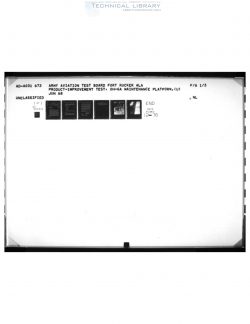AATB-AD-A031-673
- Version
- 150 Downloads
- 2.98 MB File Size
- 1 File Count
- March 1, 2017 Create Date
- March 1, 2017 Last Updated
Product Improvement Test, OH-6A Maintenance Platform

3. Description of Materiel. The maintenance platform (figure I , in- closure 2) attaches to the jack point on the right side of the aircraft at the cargo door. This non-adjustable platform is positioned for direct access to areas above the right cargo door and is designed to be stowed internally within the aircraft cargo compartment. The surface of the platform is coated with an antiskid material to permit use during wet weather and to minimize the adverse effects of spilled oil or grease.
5. Test Objective s. To dete rmine: a. Weight and dimensions. b. Installation requirements. c. Functional suitability. d. Safety. e. Design deficiencies. b. Special installation hardware consisted of a bracket which attached to the inside right-hand aft cargo door frame (figure 2, inclo— sure 2). This bracket and the jack point below the door insure rigidity of platform installation. One man-hour, including time required to gain access to the work area, was necessary for bracket attachment.
c. The maintenance platform allowed limited access to the main rotor and engine inlet areas. However, perforrnance of maintenance tasks in these areas was limited by the inability to adjust platform height. d. USA BAA R personnel found that the platforrn working area was not sufficiently large to permit safe inspections of both the engine in— let and main-rotor hub areas. Maintenance personnel standing on the platform and attempting to gain access to the engine inlet area had to lean sideward at least 30 degrees toward the rear of the aircraft, remove one foot from the platform, and maintain balance. e. The following design deficiency was found: Present platforrn working area and position preclude safe and effective access to both the engine inlet and the main-rotor hub areas (paragraphs c and d, above). An increase Of platform working area length to 48 inches should allow safe access to the engine inlet area and decrease the safety hazard associated with the test platforrn.
7. Conclusion. The maintenance platform in its present configuration is not suitable for use on the OH-6A. 8. Recommendation. It is recommended that the design deficiency be corrected by increasing the platform working area to allow safe and effective access to the engine inlet.
| File | Action |
|---|---|
| AATB-AD-A031-673 Product Improvement Test, OH-6A Maintenance Platform.pdf | Download |

Comment On This Post